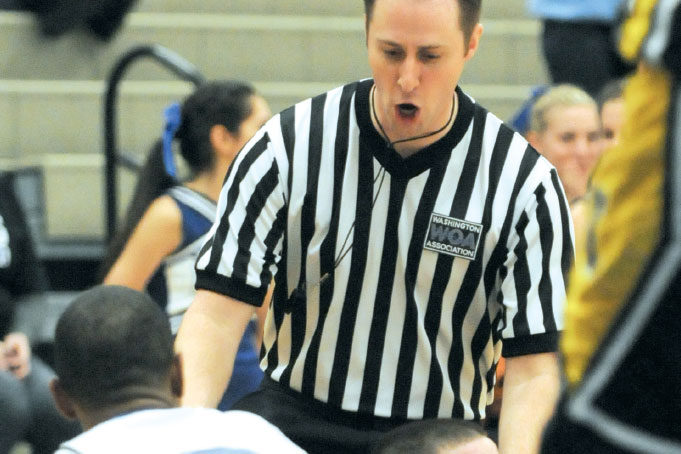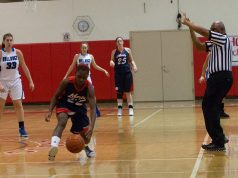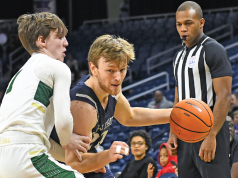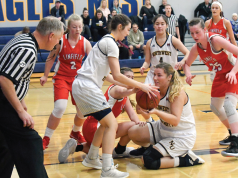Most of us are well aware that bad judgment or lack of focus in the last minute of a game can destroy the other 98 percent of a fine effort. We check to make sure there are no scorebook or possession-arrow problems as we approach that critical time in a close game. But what about others? Here are some thoughts for dealing with an array of other potential pitfalls.
The foul festivals
Most have been in close games in which the losing team fouls repeatedly in the last minute. Officials know that will be the strategy, but need to deal fairly and firmly with three issues: consistency, avoiding violence and intentional fouls.
Consistency is a significant issue. If you did not rule a finger touch on the forearm a foul in the first quarter, don’t call it a foul in the last minute.
Why not? You know that the trailing team wants to foul. Perhaps it only has five team fouls and needs to get two more to put the opponent on the line. A couple of quick fouls with no argument will move the game along, right?
Think about the words above. If you call the touch a foul in that situation, you are becoming part of the fouling team’s strategy. You are forcing the leading team to shoot a free throw or make a throw-in prematurely when seconds are valuable. Throw-ins are dangerous. They can be picked off, bobbled, tied up or even result in a violation. You are charged with being fair for the whole game. Remind the players that they need to make a basketball play, and be consistent in what you rule to be a foul.
That being the case, we need to forestall violence. If you don’t call the touch foul, some player, blindly following his or her coach’s wishes, might tackle the player with the ball. A combination of communication and instant punishment is all you can do. As a preventive measure, talk to the captain during a foul shot or as the team comes out of a timeout to remind them to play the ball. If the tackle still comes, call the intentional foul.
It is unfair to rule an obvious intentional action, regardless of severity, as a common foul. Dribblers are pushed in the back when the defender has no chance to reach the ball; players far away from the ball are hugged in front of an official. It is not being chicken or naïve to enforce the rule. Some veterans will say, “They were going to shoot two anyway,” but that does not cut it. Retaining possession is important. Get on the same page with your partner(s) and call the first intentional foul. That will clean up the game and make clear that the rule will be enforced.
Last-minute delays
If a player interferes with the ball after a basket to delay an opponent’s throw-in, issue a warning for the first offense. However, in the closing seconds of a close game, that can be used as an unsporting effort to get you to stop the clock for the team’s advantage. An immediate technical foul is warranted if the thrower’s efforts to make a throw-in are affected. If not affected, it should be ignored when the only purpose is to stop the clock (NFHS 9.2.10A Comment).
The blowout
Whether or not any state-adopted “mercy” rule is in effect, officials cannot lose focus in a blowout. Even if you ignore a minor miscue by the losing team, taunting by the winner and frustration reactions by the losers need to be prevented.
If you see tensions mounting, get the captains of both teams together to ask for cooperation in defusing the situation. If that fails, keep working harder than the teams and be alert for trouble until the final horn.
The walk-off
It has become fashionable for players to start off the court in the last few seconds when the outcome is clear. The game is not over. A player might throw you the ball. You may instinctively block it to keep it inbounds or, worse, a player might keep playing and steal the ball, tempting a “sophisticated” opponent to tackle him or her.
Be alert for that kind of trouble. You might find a moment to ask both teams to keep playing as the situation approaches, or remind the captains and coaches at the pregame meeting or halftime intermission that you expect both teams to compete for the full 32 or 40 minutes. If you see the tackle coming, perhaps showing your stripes to the potential fouler might prevent it.
Other clowning/taunting
Fox News showed a clip of a college player dunking to give his team a three-point lead with 0.5 seconds to play, then chinning himself twice on the ring. One of the reporters was a former presidential press secretary. Even she wondered why there was no technical foul. The conference penalized the officials. If that occurs in a high school game, time will run out by the time you call the technical. Since there will be no shots, you can charge the foul and leave.
There are less bizarre examples of that kind of nonsense. Verbal taunting can be followed by confrontations or bench players can run onto the court before the horn. Call the necessary technical fouls and leave with your head held high.
Keep your focus sharp to avoid surprises and have the courage to enforce all the rules.
What's Your Call? Leave a Comment:
Note: This article is archival in nature. Rules, interpretations, mechanics, philosophies and other information may or may not be correct for the current year.
This article is the copyright of ©Referee Enterprises, Inc., and may not be republished in whole or in part online, in print or in any capacity without expressed written permission from Referee. The article is made available for educational use by individuals.


















